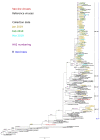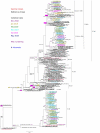Influenza Vaccine Effectiveness and Waning Effect in Hospitalized Older Adults. Valencia Region, Spain, 2018/2019 Season
- PMID: 33514058
- PMCID: PMC7908304
- DOI: 10.3390/ijerph18031129
Influenza Vaccine Effectiveness and Waning Effect in Hospitalized Older Adults. Valencia Region, Spain, 2018/2019 Season
Abstract
Influenza vaccination is annually recommended for specific populations at risk, such as older adults. We estimated the 2018/2019 influenza vaccine effectiveness (IVE) overall, by influenza subtype, type of vaccine, and by time elapsed since vaccination among subjects 65 years old or over in a multicenter prospective study in the Valencia Hospital Surveillance Network for the Study of Influenza and other Respiratory Viruses (VAHNSI, Spain). Information about potential confounders was obtained from clinical registries and/or by interviewing patients and vaccination details were only ascertained by registries. A test-negative design was performed in order to estimate IVE. As a result, IVE was estimated at 46% (95% confidence interval (CI): (16%, 66%)), 41% (95% CI: (-34%, 74%)), and 45% (95% CI: (7%, 67%)) against overall influenza, A(H1N1)pdm09 and A(H3N2), respectively. An intra-seasonal not relevant waning effect was detected. The IVE for the adjuvanted vaccine in ≥75 years old was 45% (2%, 69%) and for the non-adjuvanted vaccine in 65-74 years old was 59% (-16%, 86%). Thus, our data revealed moderate vaccine effectiveness against influenza A(H3N2) and not significant against A(H1N1)pdm09. Significant protection was conferred by the adjuvanted vaccine to patients ≥75 years old. Moreover, an intra-seasonal not relevant waning effect was detected, and a not significant IVE decreasing trend was observed over time.
Keywords: effectiveness; hospitalizations; influenza; surveillance; vaccine; waning.
Conflict of interest statement
J.D.D. has been Principal Investigator in Clinical Trials sponsored by SPMSD, MSD, GSK, and Pfizer. J.D.D. acted as Advisor for GSK and SPMSD. Other authors declare no conflict of interest. Sanofi Pasteur had no role in the design of the study; in the collection, analyses, or interpretation of data; in the writing of the manuscript, or in the decision to publish the results.
Figures




References
-
- World Health Organization (WHO) Influenza Virus Infections in Humans. [(accessed on 8 September 2020)]; Available online: https://www.who.int/influenza/human_animal_interface/virology_laboratori....
-
- World Health Organization (WHO) Recommended Composition of Influenza Virus Vaccines for Use in the 2018–2019 Northern Hemisphere Influenza Season. [(accessed on 8 September 2020)]; Available online: https://www.who.int/influenza/vaccines/virus/recommendations/201802_reco....
-
- European Centre for Disease Prevention and Control (ECDC) Influenza Virus Characterization. [(accessed on 8 September 2020)]; Summary Europe. June 2019. Available online: https://www.ecdc.europa.eu/sites/portal/files/documents/ECDC%20Flu%20Vir....
-
- The Francis Crick Institute (TFCI) Reported Prepared for the WHO Annual Consultation on the Composition of Influenza Vaccine for the Northern Hemisphere 2019–2020. [(accessed on 8 September 2020)]; Available online: https://www.crick.ac.uk/sites/default/files/2019-04/Crick%20VCMFeb2019%2....
-
- Kissling E., Rose A., Emborg H.-D., Gherasim A., Pebody R., Pozo F., Trebbien R., Mazagatos C., Whitaker H., Valenciano M., et al. Interim 2018/19 influenza vaccine effectiveness: Six European studies, October 2018 to January 2019. Eurosurveillance. 2019;24:2–14. doi: 10.2807/1560-7917.ES.2019.24.1900121. - DOI - PMC - PubMed
Publication types
MeSH terms
Substances
LinkOut - more resources
Full Text Sources
Other Literature Sources
Medical
Research Materials

